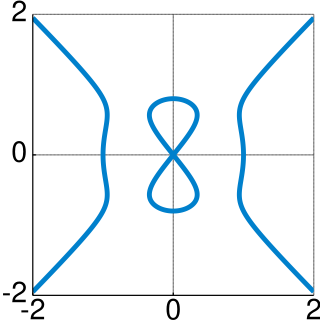Top Qs
Timeline
Chat
Perspective
Devil's curve
Algebraic plane curve From Wikipedia, the free encyclopedia
Remove ads
In geometry, a Devil's curve, also known as the Devil on Two Sticks, is a curve defined in the Cartesian plane by an equation of the form[1]


i.e. a Quartic, in terms of x and y.
The polar equation of this curve is of the form
Devil's curves were discovered in 1750 by Gabriel Cramer, who studied them extensively.[2]
The name comes from the shape its central lemniscate takes when graphed. The shape is named after the juggling game diabolo, which was named after the Devil[3] and which involves two sticks, a string, and a spinning prop in the likeness of the lemniscate.[4]
For , the central lemniscate, often called hour-glass, is horizontal, For it is vertical. If , the shape becomes a circle. The vertical hour-glass intersects the y-axis at . The horizontal hour-glass intersects the x-axis at and for the four turning points, for this hour-glass, giving:
Total Area of horizontal hour-glass
Remove ads
Electric Motor Curve
A special case of the Devil's curve occurs at , where the curve is called the electric motor curve.[5] It is defined by an equation of the form
The name of the special case comes from the middle shape's resemblance to the coils of wire, which rotate from forces exerted by magnets surrounding it.
Remove ads
References
External links
Wikiwand - on
Seamless Wikipedia browsing. On steroids.
Remove ads













